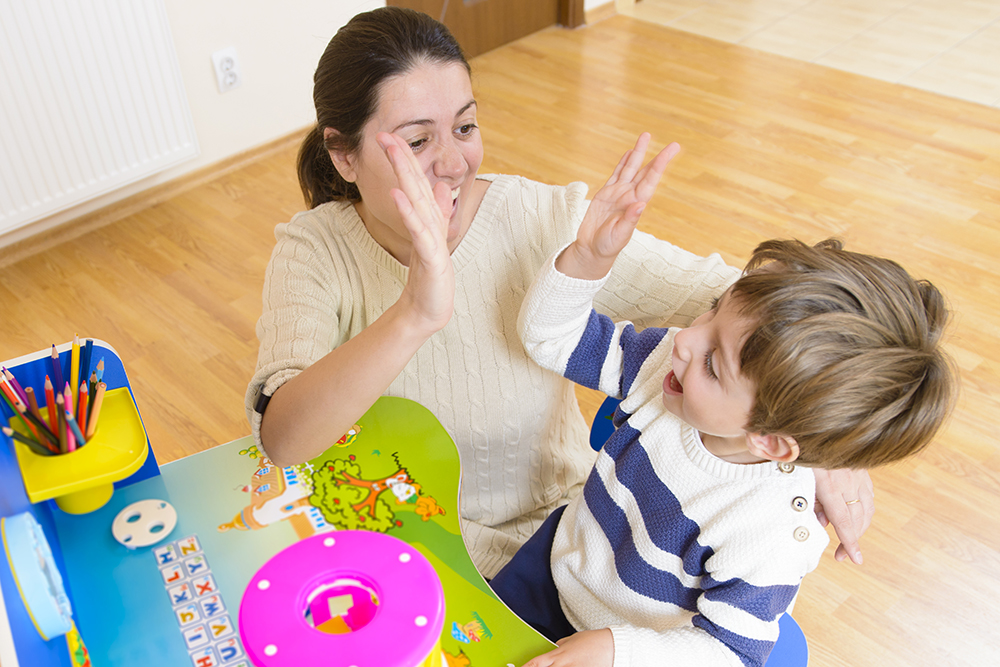Unlike conventional schooling, home education allows families to tailor the educational experience to fit their child’s unique needs, interests and learning pace.
Home education in the UK is legally recognised and can take many forms, depending on what works best for the child and the family. Some parents may choose a structured approach that mirrors the school curriculum, while others might adopt a more autonomous style, allowing the child to explore subjects that interest them most. The beauty of home education lies in its adaptability - whether through formal lessons or experiential learning, it can be customised to suit the individual learner.
This approach offers the opportunity for children to learn in a way that aligns with their natural curiosity and rhythm, providing a truly bespoke educational experience.
Contents of the guide
Click the links below to navigate our guide to home education
- Before you start
- Getting started at home
- Different home education approaches
- Things to consider
- Choosing a curriculum
- Resources and support
- Practical considerations
- Assessments and progress monitoring
- Is home education right for me?
Getting Started with Home Education
Legal Requirements
Starting home education in the UK involves several key legal steps, especially if your child is currently enrolled in a traditional school. Here’s what you need to do:
- Deregister Your Child from School:
- If your child is currently attending a school, you must formally notify the headteacher in writing that you intend to withdraw your child from school to educate them at home. This letter should clearly state the date from which your child will no longer attend the school.
- The headteacher is required to remove your child’s name from the school register upon receiving this notification. If your child attends a special educational needs (SEN) school, you will need the local authority's permission to deregister them, but this permission should not be unreasonably withheld.
-
Notifying Your Local Authority:
- While there is no legal requirement to notify your local authority if your child has never attended a school, it’s often recommended to do so. This can help establish a positive relationship with the authority, which may contact you to ensure your child is receiving a suitable education.
- Local authorities have a duty to ensure all children are receiving appropriate education, whether at school or through home education. They may make informal enquiries to confirm that your child’s educational needs are being met, but they do not have the right to dictate how you educate your child unless they believe the education is insufficient.
Getting Started at Home
Once you have completed the necessary legal steps, it’s time to focus on the practical aspects of setting up a home education environment. This is especially important to focus on if you’re considering home education (or even if you’re finding out how to flexi-school your child instead), as you need to make sure your child is both happy and productive when learning at home.

- Create a Dedicated Learning Space: Set aside a specific area in your home where your child can focus on their studies. This doesn’t need to be a formal classroom setup; it can be a cosy corner of the living room or a quiet spot in their bedroom, as long as it’s free from distractions and conducive to learning. Things like how students sit, the light and fresh air all help create a positive environment.
- Gather Educational Resources: Equip your home with the necessary educational materials. This might include textbooks, workbooks, educational games, and access to online resources. Consider using platforms which offer a range of curriculum-aligned resources that can help structure your child’s learning journey.
- Establish a Routine: While one of the benefits of home education is flexibility, having a consistent daily or weekly routine is important to maintain structure. This routine doesn’t have to mirror a traditional school day exactly but should include regular study times, breaks, and opportunities for physical activity and creative exploration. More on this below.
These steps are important to help your child be successful when being educated from home, and depending on the situation it can be a more effective way of learning than traditional schooling for some.
Different Home Education Approaches
When embarking on the home education journey, one of the key decisions you'll make is choosing the educational approach that best suits your child’s needs and learning style. There are several approaches to consider, each offering a different method of facilitating learning at home.

Here are some of the different methods you need to know:
Structured Education:
- What It Is: Structured education closely mirrors the traditional school system, with set subjects, a timetable, and formal assessments. This approach may follow the National Curriculum or another established curriculum, providing a clear framework and measurable progress.
- Benefits: This method is ideal for families who prefer a clear structure and routine, and is as close to traditional schooling as you can get without learning in a school environment. It ensures comprehensive coverage of core subjects and may ease transitions back into traditional schooling if needed.
Autonomous Learning (Unschooling):
- What It Is: Autonomous learning, often referred to as unschooling, is a child-led approach where learning is driven by the child’s interests rather than a predetermined curriculum. Children explore subjects that capture their curiosity, learning through everyday experiences, play, and exploration.
- Benefits: This approach fosters a love of learning by allowing children to pursue their passions and learn at their own pace. It’s particularly effective for children who thrive in less structured environments or have specific interests they wish to explore deeply.
Eclectic Education:
- What It Is: Eclectic education is a flexible approach that combines elements of both structured education and autonomous learning. Parents may use a structured curriculum for certain subjects while allowing more freedom in others, adapting to the child’s needs as they evolve.
- Benefits: This approach offers the best of both worlds, providing structure where necessary while also accommodating the child’s individual interests and learning style. It’s highly adaptable and can change as the child grows and their educational needs shift.
Things To Consider For Home Education
Understanding Learning Styles
Understanding your child’s learning style can make a significant difference in how they absorb and retain information, helping you tailor your educational approach in a way that works for them.

Visual learners thrive when they can see information presented to them. They excel with diagrams, charts, and videos, which help them to process and remember new concepts. For these learners, incorporating plenty of visual aids into their study routine—such as mind maps for organising thoughts or flashcards for quick review—can be particularly effective. These tools allow them to visualise the information, making it easier to understand and recall later.
Auditory learners find it easiest to learn through listening. Whether it’s through discussions, lectures, or listening to educational podcasts, these learners process information best when they can hear it. Encouraging them to participate in oral presentations, read aloud, or even discuss what they’ve learned can reinforce their understanding. These auditory activities engage their primary learning channel, making information stick.
Kinaesthetic learners are hands-on individuals who need movement and physical activity to help them grasp new concepts. They often prefer learning through experience—doing rather than observing. Activities like conducting investigations, building models, or engaging in role-play can be particularly beneficial for these learners. By incorporating movement and tactile experiences into their lessons, kinaesthetic learners can connect more deeply with the material.
Reading/writing learners are those who excel when they interact with text. These learners often enjoy reading textbooks, taking notes, and writing essays. They benefit from a learning environment rich in written resources, where they can absorb information at their own pace through reading and then solidify their knowledge by writing about it. Encouraging these learners to keep detailed notes and write summaries of what they’ve learnt can help them to internalise the material more effectively.
Getting to know your child’s learning style will make a huge difference in the success of their home education, as you can help them learn in the way that works best for them, allowing them to pick things up more effectively. If your child is at a school, speak with their teachers before you start home educating to get their insight into their style too and of course, ask what your child thinks as well!
Choosing a Curriculum
Next, you need to think about the curriculum, or the ‘plan for learning’ your child will follow. Selecting or designing a curriculum for home education can seem daunting, but it’s an opportunity to create a learning path tailored to your child’s needs and interests.
-
Traditional Curricula:
- What It Is: Traditional curricula are comprehensive programs that cover all subjects and are often aligned with the National Curriculum. They provide a structured approach to learning with clear goals and objectives.
- When to Use: If you prefer a clear roadmap and want to ensure coverage of all key areas, a traditional curriculum may be a good fit. It’s particularly useful if you’re considering formal exams like GCSEs.
- Subject-Specific Resources:
- What It Is: Instead of a full curriculum, you can choose resources for individual subjects that align with your child’s interests or needs. This approach allows for flexibility and customisation.
- When to Use: This is ideal if your child has specific strengths or interests in certain subjects that you want to explore in greater depth. It allows you to focus more intensively on areas where they excel or need extra support.
- Cross-Curricular Projects:
- What It Is: Cross-curricular projects integrate multiple subjects into a single project or theme. For example, a project on space could include science (astronomy), mathematics (calculating distances), writing (non-fiction reports) and art (drawing planets).
- When to Use: This approach is effective for fostering critical thinking and making connections between different areas of knowledge. It’s particularly engaging for children who enjoy project-based learning and seeing the practical application of their studies.
Resources and Support for Home Education
Embarking on the home education journey can feel daunting at first, but with the right resources and support networks, it becomes a manageable and rewarding experience. Here’s how to find the materials and support you need to ensure your child’s education from home is as enriching as possible.
Finding Educational Resources
Sourcing high-quality educational materials is crucial for a successful home education experience. Fortunately, there’s a wealth of resources available to suit every educational approach and learning style.
- Textbooks: Traditional textbooks are a solid foundation for structured education. They provide comprehensive coverage of subjects and are often aligned with the National Curriculum. You can purchase these from educational publishers or second-hand through online marketplaces.
- Online Courses: Online courses offer flexibility and a wide range of subjects, often allowing students to learn at their own pace. Platforms like Khan Academy and Coursera provide free and paid courses on a variety of topics, suitable for different age groups and skill levels.
- Interactive Tools: To make learning more engaging, consider incorporating interactive tools into your curriculum. Websites like BBC Bitesize offer interactive lessons and quizzes across a range of subjects, while platforms like Duolingo can help with language learning through gamified lessons.
- Libraries and Educational Websites: Many public libraries provide access to a wide range of educational resources, including eBooks, audiobooks, and online databases. Websites like the Open University offer free courses and educational materials that can supplement your home education curriculum.
Community Support and Networking
Joining home education groups can be incredibly beneficial for both parents and children. These communities provide a support network where you can share experiences, exchange resources, and receive advice from other home educators.
- Local Home Education Groups: These groups often organise regular meet-ups, social activities, and group learning sessions. They can be found through social media platforms like Facebook or through local community centres. Engaging with a local group can not only provide valuable social interaction for your child, but also a sense of community for you as you navigate home education. There’s also lots of opportunities for sharing resources.
- Online Forums and Social Media Groups: If you’re looking for advice or support, online forums and dedicated home education social media groups are great places to connect with other home educators. These platforms allow you to ask questions, share resources, and find support from a wider community.
- Home Education Events and Workshops: Keep an eye out for home education workshops, conferences and fairs. These events provide opportunities to learn from experienced educators, discover new resources, and connect with other families on the same journey.
Utilising Online Learning Platforms
Online learning platforms are invaluable for home education, offering a wide range of resources that can supplement your teaching and help your child explore subjects in depth.
For instance, we provide tons of curriculum-aligned assessments and other resources like English worksheets, maths worksheets and science worksheets across a range of years.
EdPlace allows parents to track their child’s progress and tailor the learning experience to meet their individual needs, making it a comprehensive and flexible tool for home education.
We do the heavy lifting for you!
Practical Considerations in Home Education
Home education offers a flexible approach to learning, but it also requires careful planning and consideration to ensure that all aspects of a child’s development are addressed. Here are some practical considerations to keep in mind.

Establishing a Routine and Timetable
Creating a daily or weekly timetable is essential in home education to provide structure and ensure that all necessary subjects and activities are covered. While the flexibility of home education allows for a less rigid schedule than traditional schooling, having a consistent routine helps children develop good study habits and manage their time effectively.
A well-balanced timetable should include blocks of structured learning time interspersed with breaks and free time. This balance is crucial as it prevents burnout and keeps learning enjoyable. For example, you might dedicate the morning to core subjects like maths and English, with the afternoons reserved for creative activities, outdoor play, or project-based learning. Incorporating regular breaks allows children to recharge, making them more focused and productive during study times. Keeping children hydrated throughout the day also has a real impact on their ability to learn.
Additionally, involving your child in the planning of their timetable can help them feel more invested in their education and teach them valuable time management skills. Flexibility is key - be prepared to adjust the schedule as needed to accommodate your child’s learning pace and interests.
Managing Costs
Home education can be as cost-effective or as expensive as you make it, depending on the resources and materials you choose. However, budgeting is an important aspect to consider, particularly when it comes to purchasing educational materials, resources, and potentially paying for exams.
- Materials and Resources: Start by identifying free or low-cost resources, such as public libraries, online educational platforms, or second-hand textbooks. Many high-quality educational materials are available for free online, including lesson plans, worksheets, and instructional videos.
- Exams: If your child is planning to take formal exams like GCSEs or A-Levels, consider the costs associated with registering as a private candidate, which can include exam fees and the cost of using a local exam centre. It’s a good idea to plan ahead for these expenses and include them in your budget so there are no surprises.
- Extracurricular Activities: Activities such as sports, music, or art can sometimes be areas where people look to pay for lessons which can also add to the cost, but are important to keep your child active, social and creative. If you don’t feel confident delivering these yourself, look for community programs, local clubs, or online classes that offer these experiences at a reduced cost. Additionally, some local authorities may offer financial support for home-educated children with special educational needs.
By being resourceful and planning your budget carefully, you can manage the costs of home education effectively without compromising on the quality of your child’s learning experience.
Socialisation and Extracurricular Activities
One of the common concerns about home education is ensuring that children have sufficient social interaction. While home education offers a more individualised learning environment, it’s important to provide opportunities for your child to develop social skills and engage with peers.

- Social Interaction: Join local home education groups where children can participate in group learning sessions, field trips, and social events. Regular meet-ups with other home-educated children can help your child build friendships and practise social skills in a supportive environment.
- Extracurricular Activities: Encourage your child to pursue interests outside of academics, such as sports, music, art or drama. These activities not only provide social interaction but also contribute to a well-rounded education. Local community centres, sports clubs, and online classes can be excellent resources for finding extracurricular activities that suit your child’s interests.
- Community Involvement: Volunteering or participating in community events can also be a valuable way for your child to interact with people of all ages and backgrounds, further enriching their social experience.
Seeking out opportunities for socialisation and extracurricular involvement means you can ensure that your child develops not just academically, but also socially and emotionally, within the home education framework.
Assessment and Progress in Home Education
Assessing and tracking your child’s progress is a crucial part of home education, helping ensure they are meeting learning goals and developing the necessary skills for their future. While formal exams are one method of assessment, there are various alternative ways to monitor progress that can be more flexible and tailored to your child’s individual needs.
Tracking Educational Progress
In home education, you have the freedom to assess your child’s learning in a variety of ways beyond traditional exams.
One of the most effective ways to track progress is by maintaining a portfolio of your child’s work. This can include samples of writing, artwork, projects, and any other relevant work they produce. Over time, a portfolio can provide a comprehensive view of your child’s achievements and growth, making it easier to identify areas where they excel and areas that may need more attention. It’s also great for showing the progress they have made. For example, showing all the stages through which they planned, drafted, reviewed, edited and improved a piece of writing.
Projects are also an excellent way to assess understanding in a practical, hands-on manner. For example, if your child is studying history, they could create a detailed presentation or a model related to a specific period or event. This method allows them to demonstrate their knowledge creatively and comprehensively, covering various skills such as research, critical thinking, and presentation. Having the project or model as their prompt to articulate their learning is really powerful.
Conducting regular reviews or discussions with your child about what they’ve learnt can help reinforce knowledge and provide insights into their comprehension. These reviews can be informal and adapted to fit your child’s learning style, whether through conversation, written reflections, or quizzes. They also help you spot the gaps in their understanding so you know what to return to.
Encouraging your child to assess their own work can foster independence and self-awareness. This method teaches them to critically evaluate their strengths and weaknesses, helping them become more proactive in their learning.
Using these alternative assessment methods gives you a more holistic understanding of your child’s educational progress without relying solely on formal exams.
Examinations and Qualifications
While home education offers flexibility, formal qualifications like GCSEs or A-Levels can still play an important role, especially if your child is considering further education or specific career paths.
- Taking Formal Exams: Home-educated children can sit for GCSEs or A-Levels as private candidates. This involves registering with an exam centre, which could be a local school or an independent exam centre. It’s important to plan ahead, as you’ll need to arrange for any required coursework or practical components to be completed, and exam centres may have deadlines for registration.
- Pathways to Higher Education: For those considering university, obtaining A-Levels or equivalent qualifications is typically necessary. However, universities in the UK also recognise alternative qualifications, such as vocational qualifications like BTECs. Some institutions may also consider portfolios or evidence of independent learning, particularly for courses in the arts or creative fields. It’s important to check with the higher education provider exactly what their requirements are.
- Vocational Qualifications: If your child is more interested in a vocational route, there are numerous qualifications and apprenticeships available that can be pursued after, or instead of, GCSEs. These pathways can lead directly to employment or further training in a specific trade or profession.
It’s important to make sure you research and understand formal qualifications if you plan on home education and your child wants to pursue higher education. The situation can be different for different providers and the landscape can change but it will help you prepare them better for both the examinations and whatever higher learning they take on later.
So, is home education right for me?
The answer to this question depends on your family's unique needs, values and circumstances. Home education offers unparalleled flexibility, allowing you to tailor your child's learning experience to their specific interests, strengths and learning style. It can be a wonderful option if you’re seeking to create a more personalised and adaptable educational environment, or if the school environment isn’t right for your child.
However, it also requires a significant commitment of time, energy, and resources, as well as a willingness to take on the responsibilities traditionally handled by schools. If you value the ability to guide your child’s education closely, are prepared to address the challenges of planning and teaching, and are eager to engage in a more hands-on role in your child's development, home education could be an excellent choice for your family. Ultimately, it’s about finding the balance that works best for you and your child, ensuring that they receive the education and social experiences they need to thrive.











